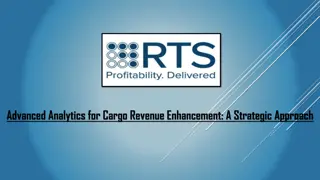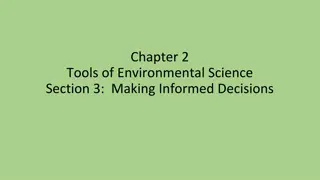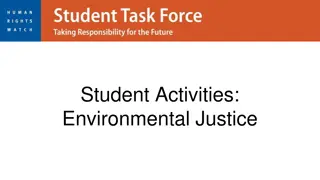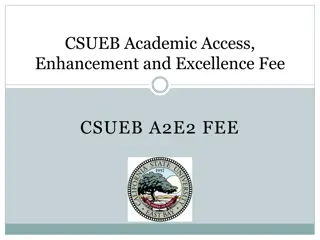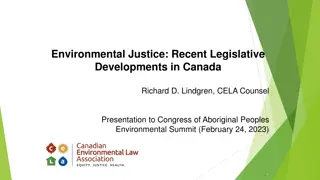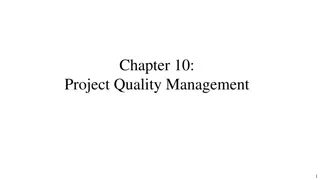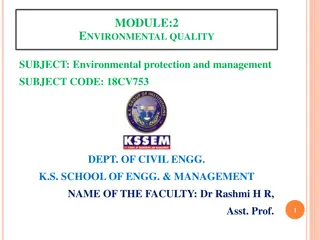
Conducting Environmental Review for Quality Enhancement
Conducting an environmental review involves assessing factors like land development, socioeconomic impacts, and natural features to determine potential impacts. The process includes 4 stages: early planning, completing the assessment, and preparing an Environmental Impact Statement when necessary. Determining the significance of impacts helps guide decision-making, with actions ranging from minor modifications to requiring more extensive analysis through an Environmental Impact Statement.
Uploaded on | 4 Views
Download Presentation

Please find below an Image/Link to download the presentation.
The content on the website is provided AS IS for your information and personal use only. It may not be sold, licensed, or shared on other websites without obtaining consent from the author. If you encounter any issues during the download, it is possible that the publisher has removed the file from their server.
You are allowed to download the files provided on this website for personal or commercial use, subject to the condition that they are used lawfully. All files are the property of their respective owners.
The content on the website is provided AS IS for your information and personal use only. It may not be sold, licensed, or shared on other websites without obtaining consent from the author.
E N D
Presentation Transcript
Step 3: Conduct the Environmental Review Environmental Assessments Slide 1
Environmental Assessment Factors HUD Exchange Environmental Review Guidance: https://www.hudexchange.info/environmental-review/ HUD Exchange Environmental Assessment Guidance: https://www.hudexchange.info/environmental- review/environmental-assessments EPA NEPAssist: https://www.epa.gov/nepa/nepassist
Purpose of the Environmental Assessment To enhance the quality of the human environment To evaluate and document each Environmental Assessment (EA) factor: Land development Socioeconomic Community facilities and services Natural Features To make a determination of anticipated impact
4 Stages of Review Stage 1: Early planning / assessment procedures Stage 2: Beginning the EA Stage 3: Completing the EA and reporting the findings Stage 4 (if necessary): Preparing the Environmental Impact Statement (EIS)
The EA: 6 steps Complete the Statutory Checklist ( 58.5) and other requirements ( 58.6) Complete the EA - including public notice, RROF, AUGF and put in your ERR Develop a meaningful project description Make and document a FONSI or FOSI determination Identify any mitigating measures Complete the EA Checklist
Determination of Significance Determination of impact for each EA factor: Minor beneficial impact Document beneficial impacts. No additional analysis needed. No impact anticipated Clearly document why no more analysis is needed Minor adverse impact Document the adverse condition, and specify if more studies, mitigation measures and/or project modifications are required Significant or potentially significant impact Requiring avoidance or modification which may require EIS
EA Factor - Land Development Conformance with comprehensive plans Compatible land use Conformance with zoning Scale and urban design
Land Development Soil suitability Slope Erosion Drainage Storm water runoff Hazards and nuisances, including site safety and noise Energy consumption Energy efficiency
Land Development Careful Site Planning Are there negative environmental impacts? Eliminate Minimize Mitigate Consider constraints such as Opportunities for site amenities Design features
Land Development - Resources Local and regional planning agency Zoning administrator Planning commission City/county architect/engineer/planner State planning office USDA soil survey Landscape architect Civil engineer Geologist-soils specialist
EA Factor - Socioeconomic Employment and income patterns Temporary jobs Permanent jobs Job requirements Demographic character changes Community characteristics Physical, social, psychological dimensions Displacement Direct Indirect Assess degree of conflict or consistency with the community
Socioeconomic Factors - Resources Local economic development authority Local planning department Local employment agency Economist at State Employment service Chamber of Commerce U.S. Census Local neighborhood organizations or advocacy groups Local health or building department housing code compliance officer Local community action agencies Local advocacy groups
EA Factor - Community Facilities and Services Key Considerations: Adequate capacity Impact and potential effect Availability Accessibility Suitability Quality
Community Facilities and Services Functional aspects residents and users need to succeed: Educational and cultural facilities Commercial facilities Health care and social services Public safety police, fire, EMS Parks, open space, recreation Infrastructure capacity to support investments: Solid waste disposal / recycling Waste water / sanitary sewers Water supply Transportation and accessibility
Community Facilities and Services - Resources School board or superintendent Commercial realtor, developer or project sponsor Local Chamber of Commerce Commercial development specialist Local planning department Local public health department Area agency on aging Local Red Cross Local social services department Local human services department Local fire department Local police department Local parks and recreation department Local cultural commission Local solid waste disposal agency Local engineer, planner, environmental specialist Local sanitary district/agency Local planning department Soils scientist Local municipal water authority Local transportation department Regional transportation authority State highway department Metropolis planning organizations
Natural Features Unique Natural Features and Water Resources Vegetation and Wildlife Other Factors Assess the impact of your proposed project on the natural features
Natural Features Unique Natural Features Key Criteria: Rareness of the feature, information content Examples: sand dunes, waterfalls, unique rock formations, caves, canyons, petrified forests, unique stands of trees, unique colonies of animals
Natural Features Water Resources Groundwater Surface water Vegetation and Wildlife Types of damage On Vegetation: Disruption Alteration of habitat On Wildlife: Disruption Habitat alteration or removal Rare / pest / game species
Natural Features - Resources State and Federal Park Service (Naturalists/Geologists) State natural heritage programs State wildlife resource management agencies Natural resource conservation service Local planning department Local public works department (engineer) US Soil Conservation Service (soil scientist) US Geological Survey (hydrologist) Local biologist or ecologist Department of Interior Fish and Wildlife Service

